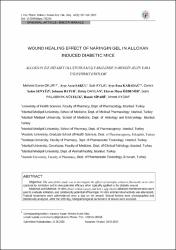| dc.contributor.author | Okur, Mehmet Evren | |
| dc.contributor.author | Şakul, Ayşe Arzu | |
| dc.contributor.author | Ayla, Şule | |
| dc.contributor.author | Karadağ, Ayşe Esra | |
| dc.contributor.author | Şahin Şenyüz, Cemre | |
| dc.contributor.author | Batur, Şebnem | |
| dc.contributor.author | Daylan, Benay | |
| dc.contributor.author | Özdemir, Ekrem Musa | |
| dc.contributor.author | Palabıyık-Yücelik, Sezin | |
| dc.contributor.author | Sipahi, Hande | |
| dc.contributor.author | Aydın, Ahmet | |
| dc.date.accessioned | 2021-01-29T11:05:38Z | |
| dc.date.available | 2021-01-29T11:05:38Z | |
| dc.date.issued | 2020 | en_US |
| dc.identifier.citation | Okur, M. E., Şakul, A. A., Ayla, Ş., Karadağ, A. E., Şahin Şenyüz, C., Batur, Ş. ... Aydın, A. (2020). Wound healing effect of naringin gel in alloxan induced diabetic mice. Journal of Faculty of Pharmacy of Ankara University, 44(3), 397-414. https://dx.doi.org/10.33483/jfpau.742224 | en_US |
| dc.identifier.issn | 1015-3918 | |
| dc.identifier.uri | https://dx.doi.org/10.33483/jfpau.742224 | |
| dc.identifier.uri | https://hdl.handle.net/20.500.12511/6454 | |
| dc.description.abstract | Objective: The aim of this study was to investigate the effects of naringin, a known flavonoid, on in vitro cytotoxicity, irritation and in vivo potential efficacy when topically applied to the diabetic wound. Material and Method: In vitro direct contact assay and hen's egg chorio-allantoin membrane tests were used to evaluate irritation, and cytotoxicity potential of Naringin. In vitro antimicrobial activity was also tested. Topical treatments were administered once a day on the wound. Wound lesions were photographed and statistically analyzed. After the 10th day, histopathological parameters of tissues were assessed. Result and Discussion: The results showed that naringin gel has no cytotoxicity and irritation potential. Also, it displayed a weak antimicrobial effect. Aside from these, in vivo studies revealed that naringin gel showed statistically higher wound contraction and re-epithelialization, the thickness of granulation tissue, angiogenesis scores. The results indicated that naringin gel effectively enhanced diabetic wound healing, and so this formulation could be considered a promising therapeutic alternative for treating diabetic wounds. | en_US |
| dc.description.abstract | Amaç: Bu çalışmanın amacı, bir flavonoid olan Naringin’in in vitro sitotoksisite, irritasyon ile diyabetik yara üzerindeki in vivo potansiyel etkilerini araştırmaktı. Gereç ve Yöntem: Naringin'in irritasyon ve sitotoksisite potansiyelini değerlendirmek için in vitro doğrudan temas deneyi ve tavuk yumurtası korio-allantoin membran testleri kullanıldı. Aynı zamanda in vitro antimikrobiyal etkinlikte test edildi. Topikal tedaviler günde bir kez yaraya uygulandı. Yara lezyonları fotoğraflandı ve istatistiksel olarak analiz edildi. 10. günden sonra dokuların histopatolojik parametrelerideğerlendirildi.Sonuç ve Tartışma: Sonuçlar, naringin jelin sitotoksisite ve tahriş potansiyeli olmadığını göstermiştir. Ayrıca, zayıf bir antimikrobiyal etki gösterdi. Bunların yanı sıra, in vivo çalışmalar naringin jelin istatistikselolarak daha yüksek yara kapanması ve re-epitelyalizasyon, granülasyon dokusunun kalınlığı ve anjiyogenezskorları gösterdiğini ortaya koymuştur. Sonuçlar, naringin jelin diyabetik yara iyileşmesini etkili bir şekilde arttırdığını gösterdi ve bu nedenle bu formülasyon, diyabetik yaraların tedavisi için umut verici bir terapötik alternatif olarak düşünülebilir. | en_US |
| dc.language.iso | eng | en_US |
| dc.publisher | Ankara University Faculty of Pharmac | en_US |
| dc.rights | info:eu-repo/semantics/openAccess | en_US |
| dc.subject | Cell Culture | en_US |
| dc.subject | Diabetes Mellitus | en_US |
| dc.subject | HET-CAM | en_US |
| dc.subject | Naringin | en_US |
| dc.subject | Wound Healing | en_US |
| dc.subject | Diabetes Mellitus | en_US |
| dc.subject | HET-CAM | en_US |
| dc.subject | Hücre Kültürü | en_US |
| dc.subject | Naringin | en_US |
| dc.subject | Yara İyileşmesi | en_US |
| dc.title | Wound healing effect of naringin gel in alloxan induced diabetic mice | en_US |
| dc.title.alternative | Alloksan ile diyabet oluşturulmuş farelerde naringin jelin yara iyileştirici etkiler | en_US |
| dc.type | article | en_US |
| dc.relation.ispartof | Journal of Faculty of Pharmacy of Ankara University | en_US |
| dc.department | İstanbul Medipol Üniversitesi, Eczacılık Fakültesi, Eczacılık Meslek Bilimleri Bölümü, Farmakognozi Ana Bilim Dalı | en_US |
| dc.department | İstanbul Medipol Üniversitesi, Tıp Fakültesi, Dahili Tıp Bilimleri Bölümü, Tıbbi Farmakoloji Ana Bilim Dalı | en_US |
| dc.department | İstanbul Medipol Üniversitesi, Tıp Fakültesi, Temel Tıp Bilimleri Bölümü, Histoloji ve Embriyoloji Ana Bilim Dalı | en_US |
| dc.authorid | 0000-0002-9354-0000 | en_US |
| dc.authorid | 0000-0003-2143-5268 | en_US |
| dc.authorid | 0000-0002-3412-0807 | en_US |
| dc.authorid | 0000-0002-8302-1127 | en_US |
| dc.authorid | 0000-0001-9416-7757 | en_US |
| dc.identifier.volume | 44 | en_US |
| dc.identifier.issue | 3 | en_US |
| dc.identifier.startpage | 397 | en_US |
| dc.identifier.endpage | 414 | en_US |
| dc.relation.publicationcategory | Makale - Uluslararası Hakemli Dergi - Kurum Öğretim Elemanı | en_US |
| dc.identifier.doi | 10.33483/jfpau.742224 | en_US |


















